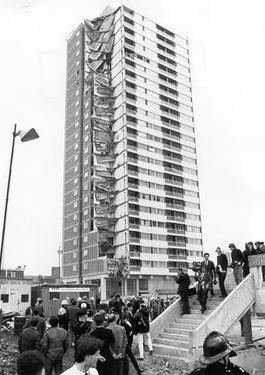 | ||
Robustness is the ability of a structure to withstand events like fire, explosions, impact or the consequences of human error, without being damaged to an extent disproportionate to the original cause - as defined in EN 1991-1-7 of the Accidental Actions Eurocode.
Contents
A structure designed and constructed to be robust should not suffer from disproportionate collapse (progressive collapse) under accidental loading. Buildings of some kinds, especially large-panel systems and precast concrete buildings, are disproportionately more susceptible to collapse; others, such as in situ cast concrete structures, are disproportionately less susceptible. The method employed in making a structure robust will typically depend on and be tailored to the kind of structure it is, as in steel framed buildings structural robustness is typically achieved through appropriately designing the system of connections between the frame's constituents.
Design considerations
Three alternative measures are used, sometimes jointly, to achieve structural robustness and reduce the risk of disproportionate collapse. These are:
Robustness requirements in Eurocodes
The requirements for structures in consequence classes 2 and 3 can be found in EN 1991-1-7 Eurocode 1 - Actions on structures - Part 1-7: General actions - Accidental actions. Additional requirements and requirements for structures in consequence class 1 can be found in the material specific Eurocode parts, EN 1992 for concrete structures, EN 1993 for steel structures and so on.
In EN 1991-1-7 buildings are categorised in consequences classes, considering the building type, occupancy and size.
Consequence class 1, low consequences of failure:
Consequence class 2a, lower risk group - medium consequences of failure:
Consequence class 2b, upper risk group - medium consequences of failure:
Consequence class 3, high consequences of failure:
For buildings intended for more than one type of use, the consequences class should be that of the most onerous type.
Buildings in consequence class 1 should be designed and constructed in accordance with EN 1990 - 1999 for satisfying stability in normal use, no specific consideration (required by EN 1991-1-7) is necessary with regard to accidental actions from unidentified causes.
Buildings in consequence class 2a (in addition to what is recommended for consequence class 1) should be provided with effective horizontal ties, or effective anchorage of suspended floors to walls.
Buildings in consequence class 2b (in addition to what is recommended for consequence class 1 and 2a) should be provided with effective vertical ties in all supporting columns and walls, or alternatively the building should be checked to ensure that upon the notional removal of each supporting column and each beam supporting a column, or any nominal section of load-bearing wall (one at a time in each storey of the building) the building remains stable and the local damage does not exceed a certain limit. Where the removal of such columns and sections of walls would result in an extent of damage in excess of the agreed limit, such elements should be designed as a key element.
For buildings in consequence class 3 a systematic risk assessment of the building taking into account both foreseeable and unforeseeable hazards, is required.
